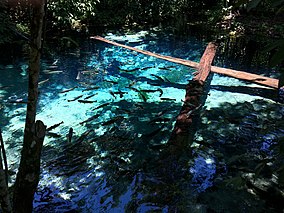
Mato Grosso is one of the states of Brazil, the third largest by area, located in the Central-West region. The state has 1.66% of the Brazilian population and is responsible for 1.9% of the Brazilian GDP.

Nobres is a city in the state of Mato Grosso, Brazil. It is located approximately 140 kilometers from Cuiabá on the south slopes of the Serra Azul.
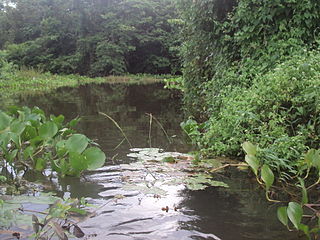
The Pantanal Matogrossense National Park is a national park in the state of Mato Grosso at the border to Mato Grosso do Sul, Brazil.
Águas do Cuiabá Ecological Station, formerly the Águas do Cuiabá State Park, is an ecological station in the state of Mato Grosso, Brazil, a fully protected conservation unit in the cerrado biome. There was controversy about the acquisition of land to expand the unit's area when it was made an ecological station.
The Igarapés do Juruena State Park is a state park in the state of Mato Grosso, Brazil.
The Tucumã State Park is a state park in the state of Mato Grosso, Brazil.
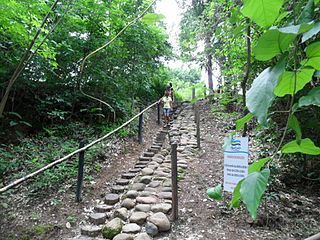
The Águas Quentes State Park is a state park in the state of Mato Grosso, Brazil
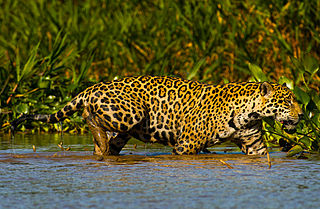
The Encontro das Águas State Park is a state park in the state of Mato Grosso, Brazil. It covers an area of the pantanal rich in watercourses.
The Serra de Santa Bárbara State Park is a state park in the state of Mato Grosso, Brazil. It preserves a unique environment where the Amazon rainforest, pantanal and cerrado meet, and holds many endemic or endangered species.

The Cristalino State Park is a state park in the state of Mato Grosso, Brazil.

The Rio Ivinhema State Park is a State park in the state of Mato Grosso do Sul, Brazil.
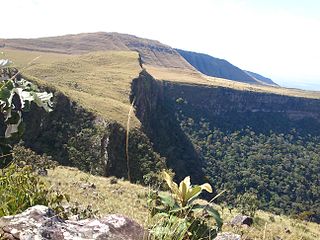
The Serra Ricardo Franco State Park is a state park in the state of Mato Grosso, Brazil. It protects the edge of a plateau on the border with Bolivia in the region of transition from cerrado to Amazon rainforest. The park has been poorly protected and is badly degraded in areas by deforestation and conversion to pasturage. It is threatened by illegal squatters, hunting and burning.
The Guirá State Park is a State park in the state of Mato Grosso, Brazil.

The Serra Azul State Park is a state park in the state of Mato Grosso, Brazil. It protects a mountainous area of cerrado forest and contains slopes that are used for paragliding. The park contains the geodetic center of Brazil.

The Sumidouro State Park is a state park in the state of Minas Gerais, Brazil. The remains of the first human inhabitants of Brazil were found in the park area in the early 19th century, along with bones of now-extinct megafauna. The main attraction is the Gruta da Lapinha, a large limestone cave.
The Zé Bolo Flô State Park, formerly the José Inácio da Silva State Park is a State park in the city of Cuiabá, capital of the state of Mato Grosso, Brazil.
The Nascentes do Rio Taquari State Park is a state park in the state of Mato Grosso do Sul, Brazil. It protects the headwaters of the Taquari River in an area in the transition between the cerrado and pantanal biomes.
The Monte Alegre State Park is a state park in the state of Pará, Brazil. The park covers a hilly region to the north of the Amazon River. It is known for its caves and prehistoric rock paintings, among the oldest archaeological remains in the Amazon region. Efforts have been made to get the local people involved in supporting sustainable tourism.
The Dom Osório Stoffel State Park is a state park in the state of Mato Grosso, Brazil. It protects an area of the cerrado biome.

The Campinhos State Park is a state park in the state of Paraná, Brazil. The environment has been much degraded by human activity and is in the process of regeneration, but there are areas of the original Araucaria Forest. The main attraction is the 500 metres (1,600 ft) long Jesuits Cave, with many speleothems such as stalagmites and stalactites.
This page is based on this
Wikipedia article Text is available under the
CC BY-SA 4.0 license; additional terms may apply.
Images, videos and audio are available under their respective licenses.
